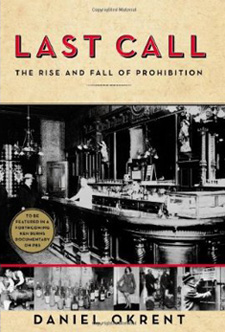 During a recent episode of the television series “Mad Men” newcomer Faye Miller told the iconic Don Draper, “I don’t know how people drink the way you do around here. I’d fall asleep.”
During a recent episode of the television series “Mad Men” newcomer Faye Miller told the iconic Don Draper, “I don’t know how people drink the way you do around here. I’d fall asleep.”
Miller serves as a proxy for those of us in the twenty-first century who are astonished at the amount of alcohol consumed during working hours on Madison Avenue in the 1960s. But why would we be? After all, as Daniel Okrent explains in Last Call: The Rise and Fall of Prohibition president James Madison drank an entire pint of whiskey daily. America and booze have always been on a first name basis, even during Prohibition.
Prohibition books come along quite regularly, but Okrent combines the sense of a historian with a great eye for detail and and ability to to entertain. For instance, one story about a sequence of events in the remote upper Michigan mining town of Iron River ultimately makes it clear why many hard working, middle class Americans would never obey the laws of Prohibition. It’s a little long to recount in detail here, so one paragraph from page 123:
Mostly, though, the press contingent got indoor pictures of Dalrymple staring down the thrity-four-year-old Mcdonough in the lobby of the Iron Inn or exterior shots of him out in the frigid February weather, sledgehammer in hand, smashing open the barrels of wine his men had managed to intercept. As vivid gouts of Dago Red saturated a nhearby snowbank, turning it a deep, grapy purple, a camerman from Pathé News gave a local man called “Necktie” Sensiba fifty cents to drop to his knees and eat the snow. The high school kids who joined him didn’t have to be paid.
His is a tale of politics — every beginning political science class should study how a collection of minorities managed to get a congressional amendment (nothing as simple as a law) passed that a clear majority clearly opposed — and thus politicians and other bigger than life characters. Grade schoolers today may not learn about Anti-Saloon League honcho Wayne B. Wheeler but Philip Seymour Hoffman would be mighty fine playing the part in a movie.
(The cover of the book says, “To be featured in a forthcoming Ken Burns documentary on PBS,” and that Okrent uses these characters to advance the plot surely appeals to Burns.)
Last Call is all encompassing — though it’s greatest strength is the chapters describing what happened during Prohibition itself — with plenty of before, during and after.
This seems almost like an aside, but although there’s plenty of beer inside it’s not really a beer book. Yet it fits quite neatly on the shelf next to Maureen Ogle’s Ambitious Brew. Okrent doesn’t detail how beer changed because of Prohibition, since, as Ogle explained, it didn’t. The road toward consolidation and a beer monoculture (dramatically reversed in the 1970s and ’80s) was paved before Prohibition.
 The Beer Babe has announced the topic of The Session #43 (Sept. 3) and
The Beer Babe has announced the topic of The Session #43 (Sept. 3) and